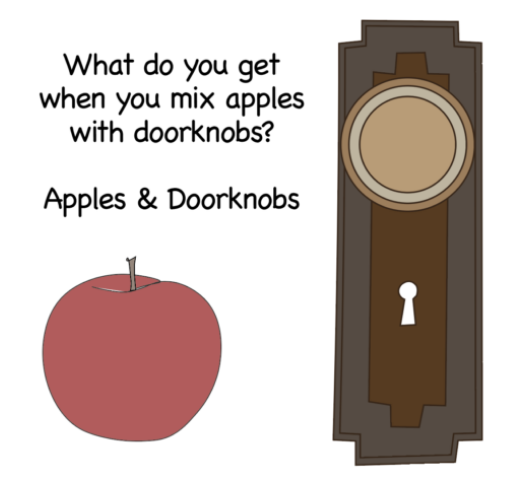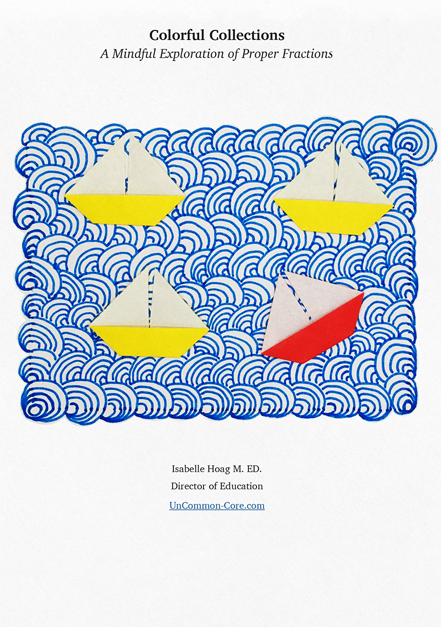
Young math students may not understand why we can’t add apples and oranges. Of course we can add apples and oranges! And bananas. And kiwis. And cherries. And pineapples. And we end up with a yummy fruit salad. On the other hand…
Apples and doorknobs cannot be added together in any meaningful way. Apples plus doorknobs make … well … apples and doorknobs.
First Learn to Play the Game-
In this oral, call and response game, the teacher asks questions and the students give a choral response. Explain that we only add stuff together when they are the same kinds of things. When you first introduce this game to your class, be sure to pick a simple math fact that everyone can easily answer. Once your students become more familiar with how to play, then you can use more challenging math facts.
Start with an addition fact. Let’s use 7 + 8=15. Ask your students, “What are seven butterflies plus eight butterflies?”
Teach your class to respond with the correct numerical answer, ” Fifteen butterflies.”
This is how to play the game as long as the addends are part of the same category.
Then, call out, “What are seven butterflies and eight chickens?”
However, when the addends are different kinds of things, teach them to say, “Clunk, you can’t add butterflies and chickens.”
You can play this game while lining up, waiting in line, or whenever you have a few minutes to spare.
Then Play the Game to Learn!
To play, choose a math fact that your students need to practice; seven plus eight for example. Remind your students that 7 plus 8 is 15.
| Call: | Response: |
|---|---|
| 7 apples plus 8 apples? | 15 apples |
| 7 doorknobs plus 8 doorknobs? | 15 doorknobs |
| 7x plus 8x? | 15x |
| 7/10 plus 8/10? | 15 tenths |
| 7 hundred plus 8 hundred? | 15 hundred |
| 7 halves plus 8 thirds? | CLUNK! You can’t add apples & doorknobs! |
| 7 sixths plus 8 sixths? | 15 sixths |
| 7 million plus 8 million? | 15 million |
| 8 pencils plus 7 pencils | 15 pencils |
Use Spaced Repetition to Make Math Facts Sticky
Spaced repetition is one of the most powerful strategies to use when you want students to remember information. Here is an easy way to schedule math fact practice so that your class will learn their math facts quickly and easily:
Play with the same math fact all day every day until your students remember it automatically. Play at least three times a day – morning, noon, and just before school’s over. Then, move on to another math fact. Be sure to bring back 7+8 every once in a while until you are sure your students couldn’t possibly forget it.
Adaptations
Apples and Doorknobs can also be used with multiplication and division facts with some modifications. Plan ahead before you get started because it is easier when you add zeros to one factor only. Also, you will want to plan more carefully when calling out multiplication and division facts.
Mix up the ways you ask them to multiply. For example:
- What is the area of a room that’s 8 feet by 7 feet?
- How long are eight 7 inch pencils?
- If you clap eight claps, seven times, how many claps in total?
- If you have 7 groups with 8 items in each group – how many items are there?
- How many weeks in 56 days?
- How many sides on 7 octagons?
- How many arms on 7 octopus?
You could also play without the apples and doorknobs. “What is 7 times 8?” They will call back “56.” Then ask, “What is 7 times 80?” The class will call back “560”. “What is 7 times 8 million?” “56 million!” SHHHHHH, just slip it in, they may not notice.
You might give out an index card with the problem of the day written upon it for students who need additional support. Just ask who wants an equation card for the day. If you try to keep it secret and only give cards to the kids who are ‘slow at math’ there will be a stigma attached to using the cards. You may even decide to start by giving everyone an answer card.
Be sure to let the music teacher know that you are teaching a call and response game. It could be a good time to share a call and response song with your class.
This is a fun, easy game for caretakers or older siblings to learn. Have your students teach their families how to play – and make sure they get much needed math fact practice.
Apples and Doorknobs is a fun, quick game to help students recall math facts & develop number sense. It gives students experience in determining when numbers can be added/subtracted or multiplied/divided together.
Share This Story, Choose Your Platform!
Download Colorful Collections:
A Mindful Exploration of Proper Fractions
Help your students make sense of fractions.
I started teaching in 1987, which means I’ve collected many tips and tricks along the way. In this ebook, I share concepts, strategies, and classroom materials to help you make math sticky.
Along with this useful ebook, you will receive weekly emails from StickyMath@UnCommon-Core.com. I send information like: teacher tips, educational ideas, book reviews, curated lists, reviews of educational sites, and free first drafts of products that I’m creating for my TPT store. That way, you get helpful ideas and free stuff, while I get some feedback before I finalize products and put them up for sale.
I value your privacy. I will never sell your information. You may unsubscribe at any time.
All the best!
Isabelle
Isabelle Hoag M. Ed.

